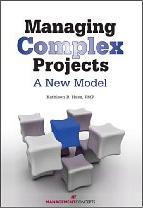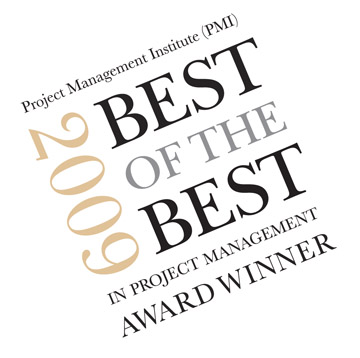|
The 2009 PMI Book of the Year! |
|
PMI Honors
Kathleen Hass
Managing Complex Projects, A New Model,
by Kathleen Hass

This important contribution to Complex Project Management was
awarded the 2009 PMI David I. Cleland Project Management
Literature Award, to recognize and honor the best project
management literature published during the previous calendar
year.
|

View Press Release |
|
|
|
Denver, CO – October 10, 2009 - PMI announced
the winner of the 2009 Book of the Year,
Managing Complex
Projects, A New Model, a groundbreaking study of complex
project management, accompanied by practical application of
complexity management techniques.
As needs change and challenges grow, project management
continues to evolve to meet 21st century demands. In
Managing Complex Projects:
A New Model, author Kathleen B. Hass addresses what it takes
for an organization to thrive, indeed to survive, in an
environment rife with uncertainty. Ms. Hass offers a method for
dramatically improving the performance of today’s large-scale
projects. She shows how complexity thinking can complement
conventional project management approaches to enable project
managers and leadership teams to manage large-scale initiatives
successfully.
Ms. Hass has developed a Project Complexity
Model that will empower project decision-makers to assess a
project’s various complexity dimensions, determine the project’s
complexity profile, and apply appropriate techniques to maximize
successful results. By applying a simple project complexity
formula, the project manager can tailor an approach that takes
into account the project’s dynamic features, such as team
composition and performance; the urgency and flexibility of
cost, time, and scope; strategic importance and political
implications; and levels of organizational and commercial
change.
The simplicity of the model is what makes it
so artful—and useful. The Project Complexity Model provides a
framework for diagnosing complexity on a wide range of projects.
Depending on the level of complexity of a particular project,
the reader is guided through a straightforward process designed
to ensure that the most suitable project leader is selected and
the most appropriate project cycle is used. Ms. Hass then turns
to a project’s complexity dimensions, offering practical
suggestions for adopting a management approach that responds to
each successfully. She addresses the complexity dimensions of
large, long-duration projects; large, dispersed, culturally
diverse project teams; highly innovative, urgent projects;
ambiguous business problems, opportunities, and solutions;
projects with poorly understood, volatile requirements;
high-visibility strategic projects; large-scale change
initiatives; projects with significant risks, dependencies, and
external constraints; and projects with a high level of IT
complexity.
Preface
I
have been working in the project environment for more than
twenty-five years. During that time I have developed a keen
understanding of the degree of difficulty that is involved in
managing projects of any size. As projects get bigger and more
complex, we tend to “do more of the same” applying ever great
degrees of rigor in the way of methods, reviews and tests,
resulting in higher-costs, and not necessarily returning value.
The Movement Has Started
|
|

(Amazon.com)
|
It is now becoming
clear that our conventional project management processes are
inadequate when managing complex projects. Research is underway
by the Project Management Institute and others determine what
makes projects complex, and to learn how to manage project
complexity. Many thought leaders in the field of project
management are presenting alternative approaches to managing
complex projects; you will see many of these works cited in this
book.
So the movement has started. Unprecedented change
is occurring all around us because of the global economy, the
internet and the omnipresent nature of information technology.
Since projects are our means to execute strategies and react to
changes in the marketplace, the capability to do project
management effectively is no longer an option. If organizations
are unable to execute projects, their very survival is likely to
be at risk. Since the stakes are so high, we are beginning to
redefine project success to be about delivering business value
as opposed to simply delivering on time, on budget and on scope.
Yet, our ability to manage complex projects is immature and
inadequate. We are now realizing that new approaches are
desperately needed to manage complex projects in the
ever-changing global economic environment.
|
|
Introducing the Project Complexity Model
This book does not
attempt to define project complexity; we will leave that to the
academics. What we do is explore the nature of complexity theory
as it applies to projects. We argue that complexity abounds in
21st century projects; that project teams are complex adaptive
social systems nested within companies, which are also complex
adaptive systems operating within the global economy (which is
also a complex adaptive system); and that large-scale complex
business solutions must be adaptive (easy to change as the
business environment changes). Therefore, our challenge is to
learn how to employ complexity thinking to complement our
conventional project management methods to manage 21st century
projects
Who Will Benefit
This
book is groundbreaking in that it presents a new model for
project leadership teams to diagnose project complexity and to
make decisions about how to plan and manage projects based on
the project complexity profile. Anyone challenged with filling a
leadership role on a critical project will benefit from reading
about complexity theory and learning how to apply complexity
thinking to make managerial decisions on their project.
It is no long just about the project manager. Combining
disciplines leads to success, and complex projects must be led
by a highly seasoned, multi-talented senior team consisting of
strategic thinkers. The complex project leadership team should
be comprised of the best resources available who are experienced
project managers, business analysts, solution architects and
developers, and a business visionary. This complex project
leadership team collaboratively diagnoses the dimensions of
project complexity using the new Project Complexity Model to
inform them about the nature of complexity that they are dealing
with. They then make managerial decisions about how to reduce
and manage the complexities. As project success improves, we
will all benefit.
A Peek Inside
The
Introduction explores the current state of project performance.
It looks at the amount of and reasons for unprecedented change
in the business environment. It then explores the track record
for project performance – which is quite alarming – and presents
the case for finding new ways to think about and manage complex
projects. The book is then comprised of four parts.
Part
One defines and explores the nature of complexity theory and
complex adaptive systems, and how complexity science can be
applied to projects. A comparison is made between convention
project management techniques versus adaptive approaches that
use complexity thinking. The Project Complexity Model is
introduced and how to use the model to help manage complex
projects is discussed.
Part Two suggests using the
Project Complexity Model to inform decisions about project
resource assignments. It provides an overview of the
competencies required to manage complex projects, discusses
strategies to develop complex project managers, and makes
recommendations to apply complexity thinking to select leaders
of complex projects.
Part Three suggests using the
Project Complexity Model to make decisions about the appropriate
project cycle to use. Part Three discusses and recommends
appropriate project cycles for independent, low-risk projects,
for moderately complex projects, and for highly complex
projects.
Part Four is the heart of the book. It
discusses the nature of complexity dimensions, the causes of the
complexity, and makes suggestions for dealing with each
complexity dimension in the Project Complexity Model. All of the
dimensions of complexity that are contained in the model are
analyzed, including: large, long-duration projects, projects
with multiple dispersed, diverse project teams, urgent projects,
projects with unclear business problems, opportunities and/or
solutions, projects with volatile, ambiguous requirements,
highly visible, politically sensitive projects, projects
involving large-scale cultural change, project dependent on
external factors and constraints, and project involving unproven
IT technology.
|
|
|